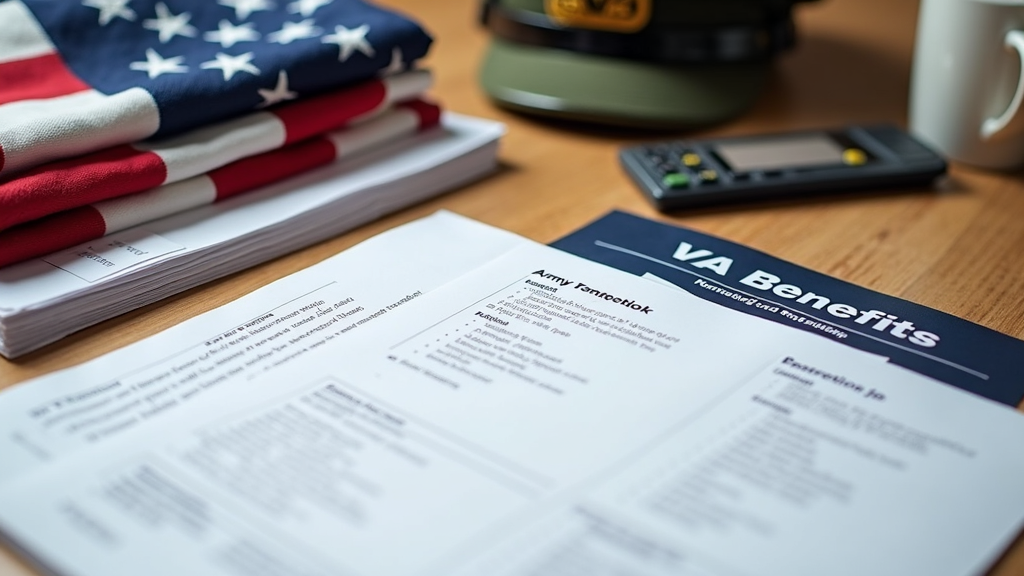Understanding the VA disability claims process can seem overwhelming the first time through, especially for retired US Army service members. Adjusting to civilian life is already a big step, so having a smooth claims experience can make things less stressful. I’m here to share what’s worked for me and fellow veterans, with direct advice to help you handle your next steps confidently.

The Basics of VA Disability Claims for Army Retirees
The VA disability claims process exists to support veterans who were injured or developed medical conditions during their service. For retired US Army members, this benefit goes a long way toward covering health issues that might not show up until years after retirement. Filing a claim involves submitting medical evidence that demonstrates a clear link, what the VA calls a “nexus,” between service and your current condition.
Recently, the VA has aimed to speed up claims, especially for retirees who might face more complex cases with several conditions. According to the VA, over 1.7 million claims were processed in 2023, highlighting just how important this support system is. Many Army retirees like me rely on it for access to care, ongoing support, and financial stability. If you are new to the process, you should know the VA has been increasing outreach and digital tools to simplify things, though face-to-face help is still widely available.
The process can be efficient when you look at it step by step: preparing documentation, filing the application, attending medical exams, and then waiting for a decision. Ensuring your forms are organized and the information is clear from the start has helped me avoid long delays.
Another important point: The VA evaluates each claim with certain standards, but the more details you provide, the smoother it goes. Many Army retirees find their applications get processed more quickly and without confusion if they include additional statements or clarifying information about their military duties and environments.
Step-By-Step: How to Start Your VA Disability Claim
Getting started means gathering key information about your service and any medical issues you believe are connected to your Army career. Here’s how I approach the main steps:
- Determine Eligibility: You’ll need an honorable (or other qualifying) discharge and a disability related to your Army service. The VA’s website lays out full details about eligibility, including for reservists and National Guard.
- Gather Documents: Prepare your DD214, service treatment records, past VA or private medical records, and supporting statements from family, friends, or fellow service members. You may also want to get copies of any previous claims or decisions.
- File the Claim: Use VA Form 21-526EZ, either online at the VA’s eBenefits portal, in person with a Veterans Service Officer (VSO), or via mail. I’ve found that working directly with a VSO helps to avoid mistakes and get personalized guidance. VSOs are trained to catch missing info and suggest improvements before you submit.
- Attend C&P Exams: The VA will schedule Compensation and Pension (C&P) exams to assess your health conditions. Be detailed and honest about your symptoms, daily impacts, and any flare-ups. These exams are super important for your claim; bring a list of symptoms or concerns so you don’t forget anything during the appointment.
- Track Status: The VA provides online updates as your claim moves through the decision process. This keeps you in the loop and lets you respond quickly to any requests for more information.
Don’t hesitate to ask questions every step of the way. There are many resources, including online guides, VA hotlines, and local offices equipped to help retired Army members.
Common Challenges and How to Handle Them
The biggest hurdles Army retirees mention are paperwork mistakes, missing deadlines, and not having all the medical proof needed. Here are a few obstacles I’ve seen and some ways to avoid them:
- Incomplete Paperwork: Missing information can slow things down. Take time to double-check every section, and don’t hesitate to ask a VSO for feedback. A bit of extra caution here pays off, and even a missing signature can set your claim back.
- Missing Medical Evidence: Get copies of your complete medical history related to service, including private doctors if you saw any. Letters from family and fellow servicemembers can also help explain how your condition affects your life and daily activities. The more context the VA has, the better.
- Service Connection Trouble: The VA has to see a clear link between your military service and claimed condition. If it isn’t obvious, talk to a VSO about gathering statements or tracking down records that show the connection. Don’t shy away from describing details like what duty stations you worked at, the nature of your tasks, or exposures you faced.
- Appeals and Denials: If your claim gets denied or rated lower than expected, you have options. The VA offers Supplemental Claims, Higher-Level Reviews, and Board Appeals. Each comes with its own timeline and process, so knowing your choices really pays off. More information is available directly from the VA’s Decision Review resources.
Sometimes it takes a few tries to get everything right. Persistence and attention to detail make a huge difference, especially during appeals or when providing additional evidence the VA requests.
What Makes Retired Army Claims Unique?
Army retirees often deal with more than one servicerelated health issue, making claims more complex. Since Army service covers a broad range of duties and exposures, from training accidents to airborne operations to environmental hazards, evidence can be wide ranging. For example, a retired Army mechanic may file for both hearing loss and a knee injury—both connected to their daily work years ago.
My experience is that detailed, organized records are especially helpful for multiple claims. Using a notebook or digital tracker to organize symptoms, appointments, and correspondence with the VA keeps everything clear and accessible. This saves time if any questions come up months down the line.
Exposure-related issues, like those related to burn pits, posttraumatic stress disorder (PTSD), or Gulf War Syndrome, can become easier to prove when you provide records that show you were stationed in those environments. The VA is increasingly recognizing these cases as more research is done, but you still need solid documentation and timelines to back up your claims.
Army retirees may also face unique circumstances, such as long deployments or specialty roles, which means their records are sometimes harder to track down. If you have missing records, the VA can help launch a search, but being prepared with any copies you have, or with witness statements, can keep things moving smoothly.
Tips for an Easier VA Claims Adventure
Simple actions can make your experience less stressful and more successful. Here are some tips I found helpful:
- Start Early: If you’re about to retire, plan ahead by collecting all records and scheduling a final medical evaluation. The earlier you get started, the less you’ll be scrambling at the last minute.
- Work With a VSO: VSOs, found through organizations like the American Legion or VFW, help ensure your claim is complete and accurate. Their services are free to veterans, and they can attend meetings or exams with you if you need support.
- Keep Everything: File away every letter, email, or phone note about your claim. If something goes missing, you’ll have your own backup documentation to show the VA.
- Be Honest and Thorough at Exams: Don’t downplay symptoms at C&P exams. If pain or functional limits are worse on certain days, make sure the examiner knows. Specific examples help the examiner understand the real impact.
- Follow Up Regularly: If the VA asks for more information or records, respond quickly. Timely updates keep your claim from stalling and show you are invested in the process.
- Create a Medical Timeline: I recommend keeping a log of symptoms, doctor’s appointments, and flare-ups. This makes it easier to show patterns over time.
Medical Evidence and Buddy Letters
Medical exams and records form the backbone of any claim. For Army retirees, “buddy letters”—signed statements from other veterans who served with you—are really helpful when a condition wasn’t always documented at the time it started. These have worked for me in clarifying how training injuries affected my health even if I didn’t seek immediate treatment. These letters can come from fellow soldiers, supervisors, or even family who saw your struggles first hand.
If you’re collecting buddy letters, try to have them address specific events, places, and dates. The more details, the better they support your claim.
Disability Ratings and Compensation
The VA assigns a disability percentage rating based on the severity of your verified conditions. Multiple conditions can be combined through a formula, so you might not just add the numbers together. This rating determines your monthly compensation and other benefits, including VA healthcare eligibility and possible extra payments for dependents. The VA’s Disability Compensation Rates table shows current payouts.
If you develop new conditions after your initial claim or if symptoms worsen, you can file for an increase or a new claim. I suggest reviewing your conditions annually and talking to your doctor about any changes so your documentation stays up to date.
Keep an eye on important deadlines and always update your contact information with the VA to ensure you receive all correspondence without delay.
Common Questions from Army Retirees
Over time, I’ve answered a lot of questions from Army friends about the VA disability process. Here are some that come up most often:
Question: How long does the VA claim process take?
Answer: On average, the VA takes about 100 to 150 days to process an initial claim, although complex cases may take longer. Staying organized and responding to requests quickly will help you avoid extra wait time. Some claims with complete supporting documents get decisions faster, while others, especially those involving multiple conditions, may need extra reviews.
Question: Can I work while receiving VA disability?
Answer: Yes, you can work while receiving VA disability compensation. However, if you’re receiving Total Disability based on Individual Unemployability (TDIU), you cannot earn more than a certain threshold without affecting your benefits. More about this is available on the VA’s TDIU information page.
Question: What happens if my claim is denied?
Answer: If denied, you have appeal options that include submitting new evidence, requesting a review by a more senior VA reviewer, or going before the Board of Veterans’ Appeals. Each approach has its own timeline and requirements, so it helps to work closely with a VSO. Don’t give up at the first no—many successful claims are approved on the second try with better documentation.
Key Takeaways and What Helps Most
The VA disability claims process rewards patience, accuracy, and seeking help when you need it. Staying organized, responding to every VA request promptly, and building a solid record of your medical history can make a huge difference. The support is there for Army retirees, and experience shows that persistence always pays off in the end. I encourage all Army retirees to start the process early, use resources like VSOs, and keep careful records along the way. Remember that this is your earned benefit—take the necessary steps to get the best result for your service.
